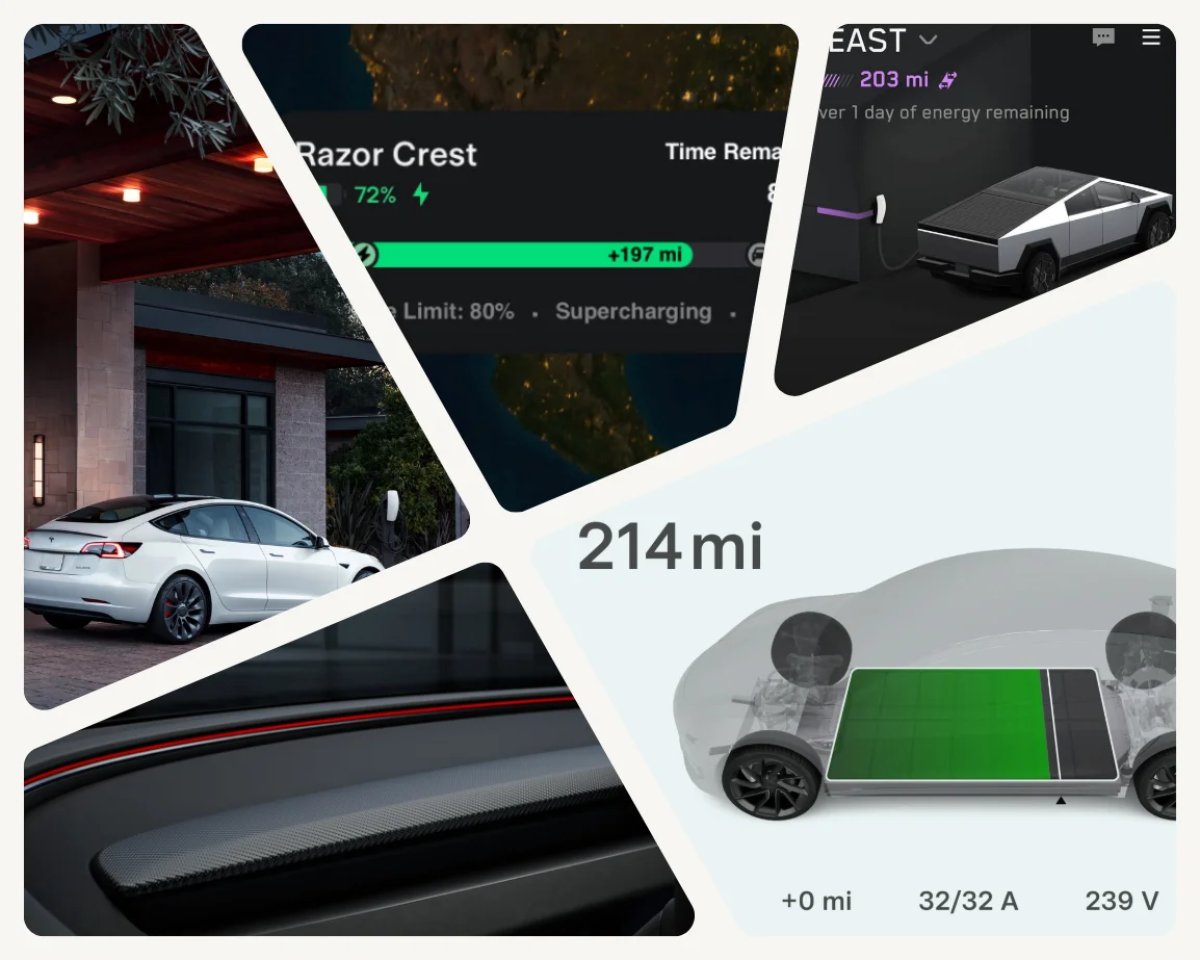By Karan Singh

As December approaches, Tesla’s highly anticipated Holiday update draws closer. Each year, this eagerly awaited software release transforms Tesla vehicles with new features and festive flair. If you’re not familiar with Tesla’s holiday updates, take a look at what Tesla has launched in the Holiday update the past few years.
While leaked features like Blind Spot Monitoring While Parked hint at thoughtful improvements, the real magic lies in the unexpected. From potential features such as the Apple Watch app to a smart assistant, the possibilities are endless.
For this chapter in our series, we’re dreaming up ways Tesla could improve the charging experience and even add some additional safety features. So let’s take a look.
Destination State of Charge
Today, navigating to a destination is pretty straightforward on your Tesla. Your vehicle will automatically let you know when and where to charge, as well as for how long. However, you’ll likely arrive at your destination at a low state of charge.
Being able to set your destination state of charge would be an absolute game-changer for ease of road-tripping. After all, the best EV to road trip in is a Tesla due to the Supercharger network. It looks like Tesla may be listening. Last week, Tesla updated their app and hinted at such a feature coming to the Tesla app. A Christmas present, maybe?
Battery Precondition Options
While Tesla automatically preconditions your battery when needed for fast charging, there are various situations where manually preconditioning the battery would be beneficial.
Currently, there is no way to precondition for third-party chargers unless you “navigate” to a nearby Supercharger. If you need to navigate to a Supercharger that’s close by, the short distance between your location and the Supercharger will also not allow enough time to warm up the battery, causing slower charging times.
In Europe, you can navigate to and precondition for Qualified Third Party Chargers, but not for unlabelled ones.
Live Activities
While we already mentioned Live Activities in the Tesla app wishlist, they’d be especially useful while Supercharging. Live Activities are useful for short-term information you want to monitor, especially if it changes often — which makes them perfect for Supercharging, especially if you want to avoid idle fees.
Vehicle-to-Load / Vehicle-to-Home Functionality
The Cybertruck introduced Tesla Power Share, Tesla’s name for Vehicle-to-Home functionality (V2H). V2H allows an EV to supply power directly to a home. By leveraging the vehicle’s battery, V2H can provide backup power during outages and reduce energy costs by using stored energy during peak rates.
Tesla Power Share integrates seamlessly with Tesla Energy products and the Tesla app. We’d love to see this functionality across the entire Tesla lineup. Recently a third party demonstrated that bidirectional charging does work on current Tesla vehicles – namely on a 2022 Model Y.
Adaptive Headlights for North America
While Europe and China have had access to the Adaptive Headlights since earlier this year, North America is still waiting. The good news is that Lars Moravy, VP of Vehicle Engineering, said that these are on their way soon.
Blind Spot Indication with Ambient Lighting
Both the 2024 Highland Model 3 Refresh and the Cybertruck already have ambient lighting features, but they don’t currently offer a practical purpose besides some eye candy. So why not integrate that ambient lighting into the Blindspot Warning system so that the left or right side of the vehicle lights up when there’s a vehicle in your blind spot? Currently, only a simple red dot lights up in the front speaker grill, and the on-screen camera will also appear with a red border when signaling.
Having the ambient lighting change colors when a vehicle is in your blind spot would be a cool use of the technology, especially since the Model Y Juniper Refresh and Models S and X are supposed to get ambient lighting as well.
Tesla’s Holiday update is expected to arrive with update 2024.44.25 in just a few short weeks. We’ll have extensive coverage of its features when it finally arrives, but in the meantime, be sure to check out our other wishlist articles:
By Karan Singh

It’s time for another dive into how Tesla intends to implement FSD. Once again, a shout out to SETI Park over on X for their excellent coverage of Tesla’s patents.
This time, it’s about how Tesla is building a “universal translator” for AI, allowing its FSD or other neural networks to adapt seamlessly to different hardware platforms.
That translating layer can allow a complex neural net—like FSD—to run on pretty much any platform that meets its minimum requirements. This will drastically help reduce training time, adapt to platform-specific constraints, decide faster, and learn faster.
We’ll break down the key points of the patents and make them as understandable as possible. This new patent is likely how Tesla will implement FSD on non-Tesla vehicles, Optimus, and other devices.
Decision Making
Imagine a neural network as a decision-making machine. But building one also requires making a series of decisions about its structure and data processing methods. Think of it like choosing the right ingredients and cooking techniques for a complex recipe. These choices, called “decision points,” play a crucial role in how well the neural network performs on a given hardware platform.
To make these decisions automatically, Tesla has developed a system that acts like a “run-while-training” neural net. This ingenious system analyzes the hardware’s capabilities and adapts the neural network on the fly, ensuring optimal performance regardless of the platform.
Constraints
Every hardware platform has its limitations – processing power, memory capacity, supported instructions, and so on. These limitations act as “constraints” that dictate how the neural network can be configured. Think of it like trying to bake a cake in a kitchen with a small oven and limited counter space. You need to adjust your recipe and techniques to fit the constraints of your kitchen or tools.
Tesla’s system automatically identifies these constraints, ensuring the neural network can operate within the boundaries of the hardware. This means FSD could potentially be transferred from one vehicle to another and adapt quickly to the new environment.
Let’s break down some of the key decision points and constraints involved:
-
Data Layout: Neural networks process vast amounts of data. How this data is organized in memory (the “data layout”) significantly impacts performance. Different hardware platforms may favor different layouts. For example, some might be more efficient with data organized in the NCHW format (batch, channels, height, width), while others might prefer NHWC (batch, height, width, channels). Tesla’s system automatically selects the optimal layout for the target hardware.
-
Algorithm Selection: Many algorithms can be used for operations within a neural network, such as convolution, which is essential for image processing. Some algorithms, like the Winograd convolution, are faster but may require specific hardware support. Others, like Fast Fourier Transform (FFT) convolution, are more versatile but might be slower. Tesla’s system intelligently chooses the best algorithm based on the hardware’s capabilities.
-
Hardware Acceleration: Modern hardware often includes specialized processors designed to accelerate neural network operations. These include Graphics Processing Units (GPUs) and Tensor Processing Units (TPUs). Tesla’s system identifies and utilizes these accelerators, maximizing performance on the given platform.
Satisfiability
To find the best configuration for a given platform, Tesla employs a “satisfiability solver.” This powerful tool, specifically a Satisfiability Modulo Theories (SMT) solver, acts like a sophisticated puzzle-solving engine. It takes the neural network’s requirements and the hardware’s limitations, expressed as logical formulas, and searches for a solution that satisfies all constraints. Try thinking of it as putting the puzzle pieces together after the borders (constraints) have been established.
Here’s how it works, step-by-step:
-
Define the Problem: The system translates the neural network’s needs and the hardware’s constraints into a set of logical statements. For example, “the data layout must be NHWC” or “the convolution algorithm must be supported by the GPU.”
-
Search for Solutions: The SMT solver explores the vast space of possible configurations, using logical deduction to eliminate invalid options. It systematically tries different combinations of settings, like adjusting the data layout, selecting algorithms, and enabling hardware acceleration.
-
Find Valid Configurations: The solver identifies configurations that satisfy all the constraints. These are potential solutions to the “puzzle” of running the neural network efficiently on the given hardware.
Optimization
Finding a working configuration is one thing, but finding the best configuration is the real challenge. This involves optimizing for various performance metrics, such as:
-
Inference Speed: How quickly the network processes data and makes decisions. This is crucial for real-time applications like FSD.
-
Power Consumption: The amount of energy used by the network. Optimizing power consumption is essential for extending battery life in electric vehicles and robots.
-
Memory Usage: The amount of memory required to store the network and its data. Minimizing memory usage is especially important for resource-constrained devices.
-
Accuracy: Ensuring the network maintains or improves its accuracy on the new platform is paramount for safety and reliability.
Tesla’s system evaluates candidate configurations based on these metrics, selecting the one that delivers the best overall performance.
Translation Layer vs Satisfiability Solver
It’s important to distinguish between the “translation layer” and the satisfiability solver. The translation layer is the overarching system that manages the entire adaptation process. It includes components that analyze the hardware, define the constraints, and invoke the SMT solver. The solver is a specific tool used by the translation layer to find valid configurations. Think of the translation layer as the conductor of an orchestra and the SMT solver as one of the instruments playing a crucial role in the symphony of AI adaptation.
Simple Terms
Imagine you have a complex recipe (the neural network) and want to cook it in different kitchens (hardware platforms). Some kitchens have a gas stove, others electric; some have a large oven, others a small one. Tesla’s system acts like a master chef, adjusting the recipe and techniques to work best in each kitchen, ensuring a delicious meal (efficient AI) no matter the cooking environment.
What Does This Mean?
Now, let’s wrap this all up and put it into context—what does it mean for Tesla? There’s quite a lot, in fact. It means that Tesla is building a translation layer that will be able to adapt FSD for any platform, as long as it meets the minimum constraints.
That means Tesla will be able to rapidly accelerate the deployment of FSD on new platforms while also finding the ideal configurations to maximize both decision-making speed and power efficiency across that range of platforms.
Putting it all together, Tesla is preparing to license FSD, Which is an exciting future. And not just on vehicles – remember that Tesla’s humanoid robot – Optimus – also runs on FSD. FSD itself may be an extremely adaptable vision-based AI.
By Karan Singh

Tesla recently rolled out power efficiency improvements to its Sentry Mode feature for the Cybertruck with software update 2024.38.4. These updates drastically improve the vehicle’s power consumption when Sentry Mode is active.
We’ve now uncovered more details on how Tesla achieved such drastic improvements in the vehicle’s power consumption, which Tesla estimated to be a 40% reduction.
Tesla made architectural changes to how it processes and analyzes video — optimizing which components handle which tasks. While the Cybertruck is the first to benefit from these advancements, Tesla plans to extend these upgrades to other vehicles in the future.
Sentry Mode Power Consumption
Tesla vehicles feature two main computers: the MCU (Media Control Unit) computer, which powers the vehicle’s infotainment center, and the FSD computer, which is responsible for Autopilot and FSD. Both of these computers remain on and powered any time the vehicle is awake, consuming about 250-300 watts.
Typically, the vehicle only uses this power while it’s awake or actively driving. It’s not a major concern since the car automatically goes to sleep and shuts down its computers after about 15 minutes of inactivity. However, the larger issue is that these computers also need to remain on when Sentry Mode is active, causing a 250-watt draw whenever Sentry Mode is on.
Interconnected System
Today, the vehicle’s cameras are connected to the FSD computer, which connects to the MCU, which is finally connected to the USB ports. Because of this interconnected setup, everything needs to remain powered. Footage needs to be streamed from the FSD computer into the MCU, where processes like motion detection occur. The data then needs to be compressed before finally being written to the USB drive. That’s a lengthy process, requiring multiple computers to remain on in order to be able to record and save live video.
Architectural Changes
Tesla is making some architectural changes to address Sentry Mode’s high power consumption by shifting the responsibilities of the vehicle’s computers. By shifting motion detection and possibly the compression activity to the FSD computer, Tesla will now be able to keep the MCU computer asleep. The MCU is still required to push the video to the USB drive, but Tesla can now wake up the system only when it’s needed.
For instance, the FSD computer will still handle the connection to the vehicle’s cameras, but it will now also detect motion. When that Sentry event occurs, it can wake up the MCU to write the data to the USB drive and then have it go back to sleep.
This approach ensures the MCU isn’t continuously powered to analyze and compress video, instead activating it only when data needs to be written.
Processor Isolation & Task Allocation
Tesla’s current architecture separates the Autopilot Unit (APU) from the MCU. This is done for several reasons – but first and foremost is safety. The MCU can be independently restarted even mid-drive without impacting the APU and key safety features.
Additionally, by isolating the APU from the MCU, tasks that are optimized for each unit—processing versus image transcoding—can be offloaded to the processing unit that’s better suited for it. This helps keep both the APU and MCU operating at their optimal power and performance parameters, helping to manage energy consumption more efficiently.
Kernel-Level Power Management
Tesla’s been working on more than just FSD or new vehicle visualization changes and has been putting in the effort to optimize the operating system’s underlying kernel. While not in heavy use, Tesla is underclocking the processors of both the MCU and APU, reducing power usage and heat generation.
Of course, other kernel optimizations and programming tricks, such as the ones Tesla uses to optimize its FSD models, also factor into the increased overall efficiency of the vehicles.
Additional Benefits
Since Tesla vehicles also include a Dashcam that processes video, it’s possible we may also see these additional power savings whenever the vehicle is awake. This could also affect other features, such as Tesla’s Summon Standby feature, which keeps the vehicle awake and processing video to give users almost instant access to the vehicle’s Summon feature.
Roll Out to Other Vehicles
While the Cybertruck was the only vehicle to receive these power improvements to Sentry Mode, we were told that they’re coming to other vehicles too. Tesla is introducing these changes with the Cybertruck first, leveraging its smaller user base for initial testing before expanding the rollout to other vehicles.
USB Port Power Management
To further conserve energy and reduce waste, Tesla now powers down USB ports, even if Sentry Mode is active. This change has impacted many users who rely on 12v sockets or USB ports to remain powered to keep accessories such as small vehicle refrigerators on.
It’s not immediately clear whether these changes to Sentry Mode impact this change or whether power to 12v outlets was removed strictly due to safety concerns.



